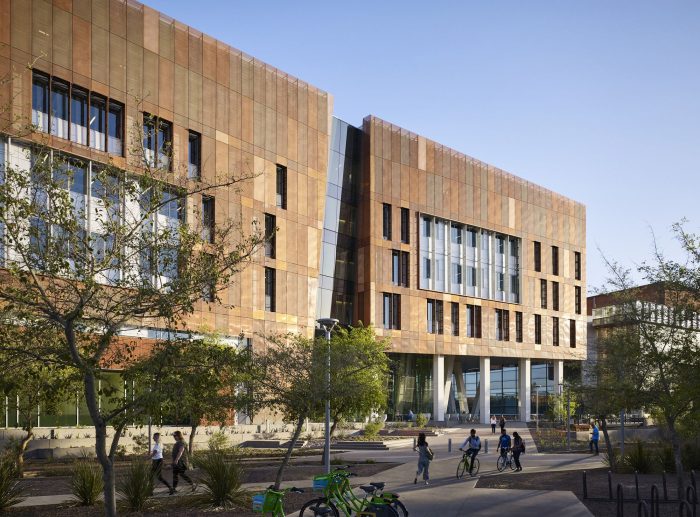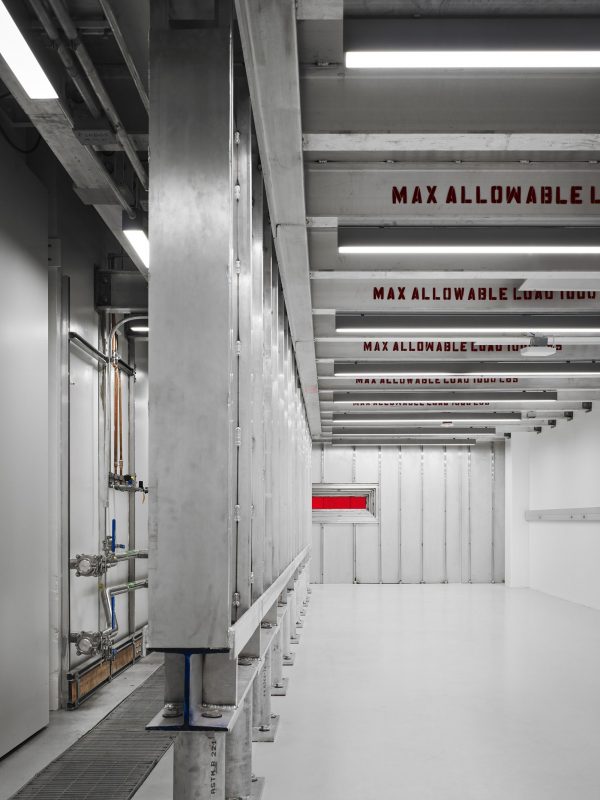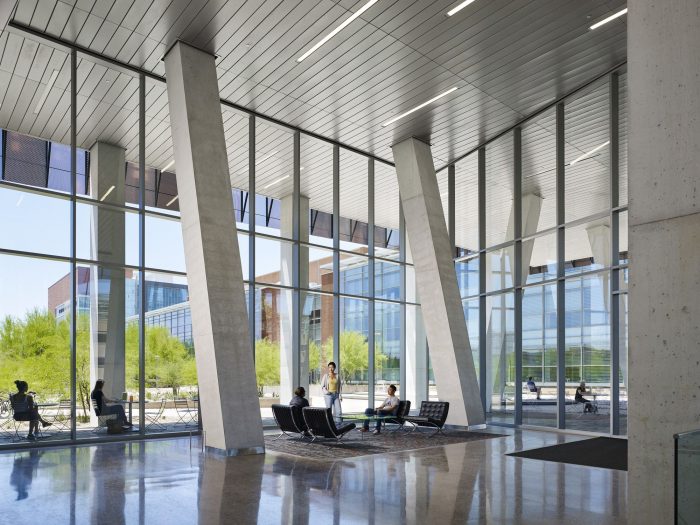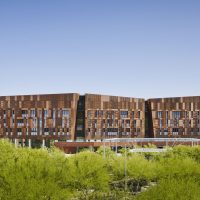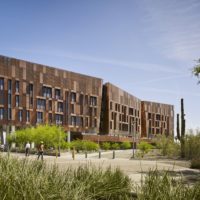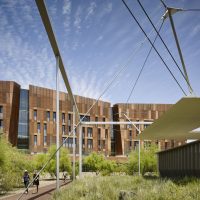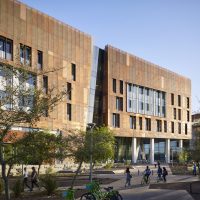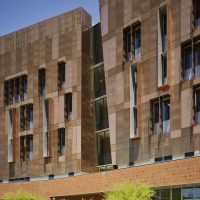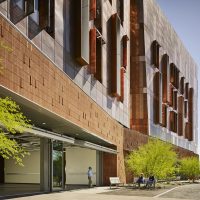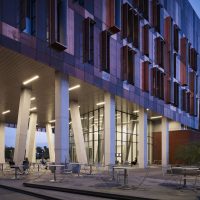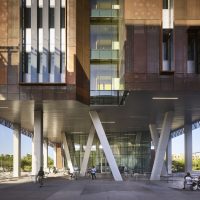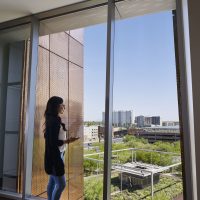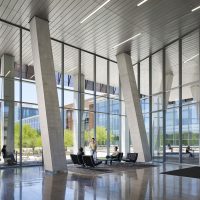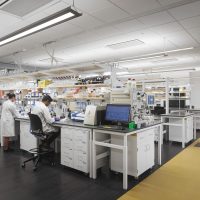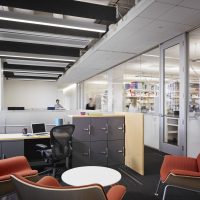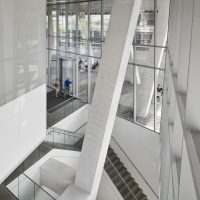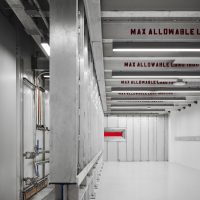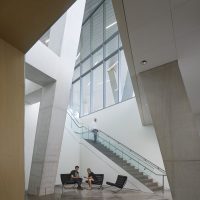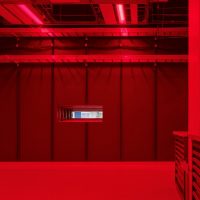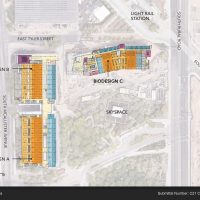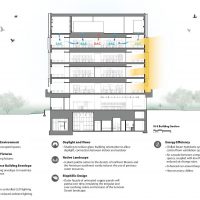Arizona State University, Biodesign Institute C designed by ZGF Architects, The 188,447 SF research facility was intended to establish an identity as a striking campus gateway, while also delivering on the client’s need for a sustainable “workhorse” laboratory building. The building’s five above-grade levels and basement will house various scientific disciplines that will utilize the building’s mixture of laboratories, which includes high bay space, high hood-density laboratories, and three levels of generic life sciences laboratories. The custom-designed, heavily reinforced basement level will house the world’s first compact X-ray free-electron laser.
The building’s primary form is an expression of the three research “neighborhoods” that comprise each floor plan. Forming the northern edge of a research quadrangle centered on a James Turrell installation, the three building segments have been strategically positioned to protect the view from within the installation. The distinctive copper exterior is a nod to Arizona’s roots (copper being one of Arizona’s historic “Five Cs” that drove the state’s early economy) and a unique expression of the reddish hue that permeates the campus architecture.
Designed to achieve LEED Platinum®, with an energy savings goal of 44% compared to existing campus laboratories, Biodesign C is intended to be the most energy efficient lab on campus. Balancing performance, aesthetics, and budget, the distinctive outer copper screen wraps around a primary skin of insulated metal panels to create a high-performance dual façade. Comprised of thousands of copper panels, the screen features eight different levels of perforation. Intensive studies of the site’s micro-climate and façade-specific conditions informed their calibration and positioning to minimize solar heat gain, optimize daylighting and visual comfort, and provide unobstructed views out.
As a shading device, the screen reduces the surface temperature of the inner façade by roughly 65 degrees on hot summer days, significantly reducing the cooling load on perimeter spaces.
Further combining form and function, a plaza has been carved out of the building’s base, which allows for al fresco breaks and meetings, despite the desert heat. Three levels of labs located directly above such a space would typically require heavy concrete shear walls. However, melding design excellence and structural integrity, a series of sloped and vertical columns was devised to provide lateral bracing. While an elegant and innovative design solution, it posed a unique challenge—some columns are angled, some upright, and one is three stories tall. Multiple large-scale mockups helped perfect the mix and formwork for each condition.
The building’s biophilic design elements are intended to foster a positive, productive indoor environment while maintaining a connection with nature and community. A 35% window-to-wall ratio and transparent layering of spaces ensure daylight floods above-grade interiors. Abundant windows and the glass-enclosed lobby overlook active campus thoroughfares and a grove of vibrant paloverdes. Glass hangar doors seamlessly connect ground-floor maker spaces with the grove. The untreated copper façade will patina gradually, emulating the irregular, ever-evolving colors and textures of the desert.
Project Info:
Architects: ZGF Architects
Location: Tempe, Arizona, United States
Lead Architects: ZGF
Area: 188447.0 ft2
Project Year: 2018
Photographs: Nick Merrick © Hall+Merrick
Manufacturers: Renlita USA, Saint Gobain, Kingspan
Project Name: Arizona State University, Biodesign Institute C
- photography by Nick Merrick © Hall+Merrick
- photography by Nick Merrick © Hall+Merrick
- photography by Nick Merrick © Hall+Merrick
- photography by Nick Merrick © Hall+Merrick
- photography by Nick Merrick © Hall+Merrick
- photography by Nick Merrick © Hall+Merrick
- photography by Nick Merrick © Hall+Merrick
- photography by Nick Merrick © Hall+Merrick
- photography by Nick Merrick © Hall+Merrick
- photography by Nick Merrick © Hall+Merrick
- photography by Nick Merrick © Hall+Merrick
- photography by Nick Merrick © Hall+Merrick
- photography by Nick Merrick © Hall+Merrick
- photography by Nick Merrick © Hall+Merrick
- photography by Nick Merrick © Hall+Merrick
- photography by Nick Merrick © Hall+Merrick
- Site Plan
- Sustainability Diagram


